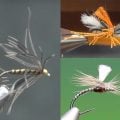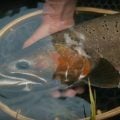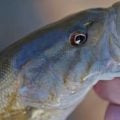“Bones”

Yellowstone Cutthroat | photo by Joshua Bergan
From the road, the Lamar River winds a twisted, blue path through bleached-yellow meadows in Yellowstone National Park’s northeast corner.
Sky-scratching, timbered ridges of granite and basalt surround the meadows. The green and brown mountains, so sudden and massive, anchor those seas of grass into place and time. Herds of bison look like scattered raisins.
Up close, after parking the truck and hiking a half-mile or so, the Lamar River is an ever-moving liquid snake that uncoils and coils through its meadows each year.
A bend that was full of water, trout and aquatic insects a year or two ago can be a dry, gritty, cobblestoned arroyo this year. On this dry, hot September day, my wading boots grated on the dry, sand-speckled rock as I trudged through wind-blown dust seeking a bend with water, insects and rising Yellowstone cutthroat trout.
Water from those high, rocky ridges rushes down into the Lamar River valley during the spring snow melt — or after the huge thunderstorms that rumble into Yellowstone National Park every summer. All that water arriving at once turns the clear river brown, and it surges over its banks and reshapes itself – sometimes several times a year.
Somehow, most of the trout and the bugs survive the dark, gritty chaos each time the river gouges a new channel. Yellowstone cutthroat have been in the Lamar River for centuries, so they’re used to constant change.
That walk from the road across the meadows and stretches of dry riverbed is always one of mystery. Will my favorite run — the one with the deep, undercut bank swarming with fish rising to size 12 Drake Mackerel mayflies — from last September still exist?
On this afternoon, I found fans of sand, dry pebbles and bison wallows where my favorite run flowed a year ago. I crouched for a moment — one of my 57-year-old knees sent an icicle of pain up my thigh — and spotted dry, white bones scattered over the rocks and sand.
Bison femurs. Elk ribs and shoulder blades. The splintered remains of a mule deer’s antler. Further on, I the lower jaw of a beaver poked up from the sand. One orange incisor jutted out of the curved architecture of the jaw — sort of like an elephant’s tusk. The incisor was still sharp, and I recalled seeing beaver teeth in a Smithsonian Institution display of American Indian tools.
I gingerly frogwalked around the dry river channel — that knee again — and more and more bones appeared. The toes of my boots hit chunks of petrified wood. As I approached the old cut bank — the high spot over a deep channel that sheltered so many greedy trout a year ago — I spotted part of a bison skull jutting out from the layers of sand and gravel. I slowly stood up and realized that I was in a landscape littered with the relics of death.
It’s not often that we humans realize that death is part of life — and is everywhere. Once you close the truck door and walk off the road, Yellowstone is a raging wilderness. What looks like a placid meadow from the air-conditioned splendor of Detroit iron is scattered with freshly gnawed bones from fresh kills — and splintering, sun-dried relics of long-dead animals. If you find dead meat — or even catch a whiff of it — it’s time to back off and find another place to cast a fly.
You don’t want a pissed-off grizz to turn you into dead meat.
This is what you think when you walk a long way from the highway to escape other anglers: At first, you’re thinking about the Yellowstone cutts rising. Then you start seeing those bones, and you think of a grizzly bear lurching up from that bison wallow and popping his teeth.
This hardly ever happens, but that bear spray hung from my wading belt for a reason. I like the idea of fishing in bear country, and I like bears, but I don’t want to see one within a mile of me — unless I’m in Detroit iron.
I’m not totally convinced that the bear spray would halt a pissed-off grizzly, but why go easy when your time comes?
After a while, you start thinking about the fish again.

Lamar River | photo by Chester Allen
I walked a couple hundred feet and came to another now-dry bend of the Lamar River. Dozens of silt-dusted elk shoulder blades littered what was a swirling, foaming backeddy during the last flood.
A memory, long buried, of pushing my hand through my boyhood sandbox surfaced in my mind. As my palm plowed the sand, some buried toy soldiers were unearthed, while others vanished.
So it goes with bones and the wandering Lamar River.
I was tempted to dig the bison skull out of the bank — it was dangling like a loose tooth — but I knew these bones belong to the riverbed and the eyes of other explorers.
An elbow of clean, blue water came into view. It was about 30 yards away. I walked toward the rushing water of the new riverbed, and suddenly, the landscape of death became one of life.
A herd of bison grazed a few hundred yards away. I turned around and saw elk and pronghorn moving through the tall, green grass that lines the living, wet part of the Lamar. They looked like they were swimming. This is how the Rocky Mountains looked 200 years ago. This is how the Lamar Valley looks every September.
Here was a new bend of the Lamar River. I got to my knees and crawled – first over wet pebbles and then into six inches of cold, clear water – into casting position at the upstream end of a deep undercut bank.
This is the kind of spot to stay low and pop downstream reach casts to the heads poking out near the cutbank. If you stand up, the trout vanish.
Drake Mackerels popped to the surface, and Yellowstone cutts took those big sailboats in those long, slow-motion, porpoising rises that I remember on a winter evenings — well after the 800-mile drive home.
A fish took my Size 12 Sparkle Dun and dug hard for the deep water of the new undercut bank. Flashes of golden-yellow lit the deep, greenish water. Graphite flexed and shook under my hand — like a long, flexible bone.
Then the fish was at my hands. A broken tibia — from a deer or pronghorn — gleamed under the water a few feet away. The cutt shook his head as I slid out the hook, and a sharp tooth sliced a shallow cut into my thumb.
The trout vanished into the deep, green undercut.
I sat back on my heels, in six inches of water, and looked at the cut bank. Long blades of prairie grass rippled in the breeze and bent in graceful arcs over the flowing water. Another cutt swirled on a big mayfly.
I looked up, and there were those alpine ridges. The sky was blue and cloudless. No rain today. No rising river or floods today.
My heart beat firmly in my chest. Sweat trickled down my back. I sucked some blood from my thumb.
Another trout rose a bit further downstream.











